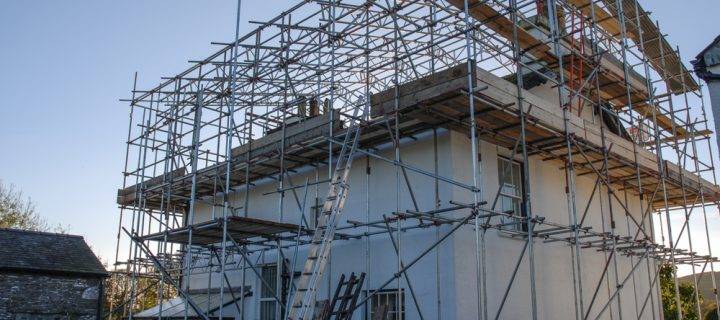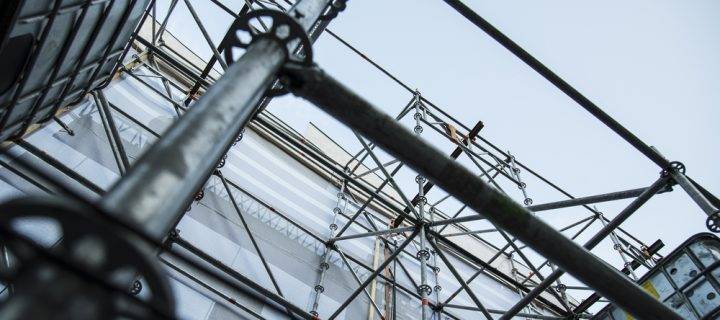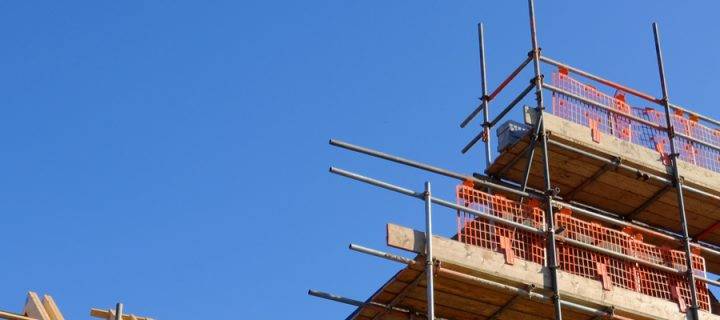Temporary roof scaffolding and covering help to guard your building’s structure when you need to repair tiles or have a leak in your roof. Here in the U.K, we have plenty of rainy days, so if you are waiting for a new roof to be installed on your property you simply can’t expose it to the elements. For our latest blog, our team of specialists are going to explore temporary roofing in more detail and explain how it works with scaffolding. How Scaffolding Temporary Roofs Work Most temporary roofs are put together in sections on the ground and then lifted into place by a crane, which reduces the amount of working at height plus it is quicker and more cost-effective. Encapsulating the sides gives your roofing a watertight finish meaning that work can continue throughout the year without the fear of any stoppages due to adverse weather. One of the most common temporary roofs specified is the UBIX system, which allows safe installation by feeding the sheeting through runners from the scaffold on either side of the structure. Here is a breakdown of the basics of the UBIX system – The light and the aesthetic weather-resistant roof is quick to assemble It can be built as a mono or duo pitch roof The roof opens to allow materials to be craned through Temporary roofs can be used as a mobile roof structure They usually span up to 15m, but greater spans are available from different suppliers Network Scaffold – The Construction Specialists Network Scaffold has been the leading the providers of scaffold and access scaffolding for projects right across Staffordshire, Nottinghamshire, Derbyshire and Loughborough for a number of years. Our hands-on approach with our clients makes us the first choice for domestic and commercial construction projects. With the recent Storm Brendan ravaging all parts of the country, you may require scaffolding to help with repairs on your property. Contact Us Today for More Information If you have any questions about our scaffold services, please contact us...
Read Moreabout Using Temporary Roofing with ScaffoldingThe country is preparing for a barrage of unpredictable weather as Storm Brendan descends on us; but what should you do with your scaffolding? The Met Office has warned of winds up to 80mph, with a weather warning issued across Monday 13th and Tuesday 14th January. Simon Partridge, Forecaster at The Met Office commented, “As it pushes through, pretty much every part of the UK will feel the influence.” Network Scaffold puts the health and safety of our clients at the forefront of our work; which is why we are sharing some handy safety tips in our latest post. Essential Scaffolding Tips to Follow Here are 8 tips for construction workers when working with scaffolding – Construction workers should never climb on scaffolds that wobble or leans to one side Before mounting the scaffold, it needs to be inspected very carefully and should not be used if a pulley, hook, block or fitting is worn out, rusted, cracked or damaged in a different manner If the scaffold has been tagged as out of service, you should stay away from it The scaffold should not be supported using objects such as bricks, blocks, barrels or boxes Guardrails or flooring need to be in the right place before being used Scaffolding should be levelled after every corner, with the adjusting leg screws shouldn’t be extended beyond 12 inches Workers on scaffolds raised above 10 feet from the ground should be worn with safety belts Your team should keep both the feet on the deck and should not sit or climb on the guardrails Want to Find Out More? Contact Us Today If you have any questions about working around weather conditions such as Storm Brendan, please get in touch today or alternatively, read our FAQ section. Network Scaffold is the leading scaffolding providers for Derbyshire, Nottinghamshire, Loughborough and...
Read Moreabout Preparing for Storm Brendan with Network ScaffoldIf you’ve never used scaffolding for a construction project before, you may not know all the components that are required. Network Scaffold are seasoned experts in erecting and dismantling scaffolding on projects right across Derbyshire, Tamworth and the surrounding areas. Every Component of Scaffolding Explained Here we are going to explain all of the components required to make your scaffolding safe and secure – Putlogs and Transoms – Putlogs and transoms should be horizontal and securely fixed to ledgers or standards with right-angled or putlog couplers. They will need to be supported with the flattened end placed right into the mortar bed joint of brickwork with putlogs approximately 75mm long. Ledgers – Ledgers should be horizontal and securely fixed to inside of standards with right-angled load-bearing couplers. They also need to be fitted in such a way that joints are staggered between bays. Ledger Bracing – Ledgers need to be fitted on alternative pairs of standards except where the width of the bays are 1.5mm or less, which means they should be fitted on every third pair. They should be fitted with ledgers or standards using load-bearing fittings, to the full height of the scaffold and start at the base level. Standards – Standards should be fitted vertically or inclined slightly towards the structure and spaced in such a way as to give sufficient support. They should also be on a base plate, or on a base plate and sole board to prevent displacement and near to ledgers. Finally, standards need to be fitted so any joints are staggered between bays. Longitudinal or Facade Bracing – These should be fitted to all scaffolds that do not get the longitudinal stability by any other means. Bracing needs to be connected to every lift of extended transoms with right-angled couplers or to every standard with swivel couplers. All joints should be manufactured with sleeve couplers. Ties – Ties link the scaffold to the structure and help to resist inward and outward movement plus they give additional longitudinal stability. Scaffold Boards – The minimum a scaffold board can overhang a putlog or transom is 50mm, with the maximum overhang dependant on the thickness of the board. Decking – Decking and working platforms...
Read Moreabout Understanding Basic Components for ScaffoldingIf Storm Gareth has affected your property, Network Scaffold Services UK Ltd can provide you with reliable and cost effective scaffolding when you need it most. The Met Office issued a yellow weather warning ahead of turbulent conditions which included 80 mph winds in some areas and heavy downpours. The HSE (Health and Safety Executive) also recently tweeted a reminder to all scaffolding companies of the Scaffold Design Checklist, in light of any incidents in the wake of Storm Gareth. Our scaffolding is ideal for on-going construction sites as well as repair work if your building has been affected by adverse weather. Here are some examples of how you can use our scaffolding systems for repairs – Damaged roofing Broken chimneys Window repair or replacement Gutter replacement Health and Safety is at the heart of our Business Here at Network Scaffold Services UK Ltd, we pride ourselves on making sure that the health and safety of our staff, clients, and the general public are covered when we start work on a project. We fully support halting work using scaffolding if we feel the safety of anyone involved or the general public could be affected. Once our specialist team start work on a project, we always work closely with customers and clients to establish the highest health and safety standards and to ensure that they are adhered to throughout. As standard only members of our qualified team are responsible for erecting and dismantling our systems, no matter how big or small the project may be. Working strictly to the Working at Height regulations of 2005, we continually invest in training for our staff to make sure they’re working knowledge of the industry is fully up to date. Trust the Scaffolding Specialists We regularly work with private individuals, local authorities, industrial, commercial and house building projects in Derbyshire and the surrounding areas. With a wealth of industry experience and expertise, we can provide you with a helping hand to get your property repaired and safe. If you’d like to know more about our services, please get in touch and our team of experts can answer any questions that you may...
Read Moreabout Do you Need Scaffolding Following Storm Gareth?Network Scaffold Services is one of the Midlands leading suppliers of scaffolding solutions for commercial, industrial and domestic buildings. As a result of our success, we’ve written a guide and checklist to scaffold design, erecting, dismantling and site surveillance. When working at heights it is imperative that the contractor you’ve chosen for your scaffolding is trained and aware of the latest regulations. Network Scaffold have always strived for continuous improvement and education of our health and safety policies. Us striving to better, allows us to deliver bespoke and safe scaffolding solutions. Our Scaffolding Process Scaffolding should be a bespoke service as no two projects are the same! At the start of the planning process, we’ll need information about your site to determine the most adequate scaffold materials in regard to length, strength, and stability when erected, dismantled and in use. The information we’ll take includes. Location Length of time the scaffolding will be in use. Intended use Height and length required How many scaffolders will be needed for the job? Access needed Any restriction or requirements needed to be taken into consideration (pedestrian walkways as an example) Surface and ground condition Building information (grading and structure) Any permission that might affect the work. As scaffolding is one of the UK’s most dangerous professions it must be erected, dismantled and operated in a safe manner. Our guidelines and policies are in place to ensure this and all member of our team is fully aware f our policies, or hey will not work on your site. As a result of our safe working conditions, we’re recognised by a number of respected third-party organisations including the Scaffolding Association and Worksafe Contractor. Get in Touch for Scaffolding from Network Scaffold So, if you’d like to know more about our services and the areas, we operate in, speak to a member of our team today. We’re happy to discuss your project in full and provide you with a no-obligation quote. Our goal is to provide services that meet your requirements and operate to maximum...
Read Moreabout Scaffolding Checklist from Network Scaffold Services




